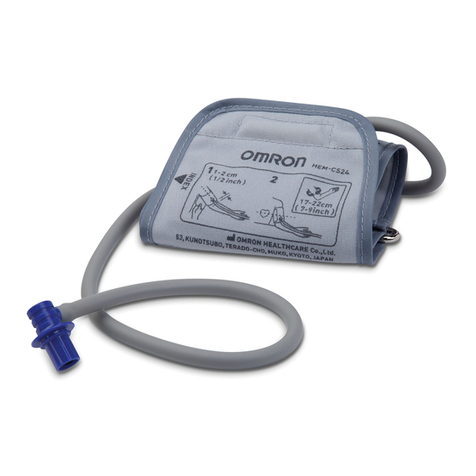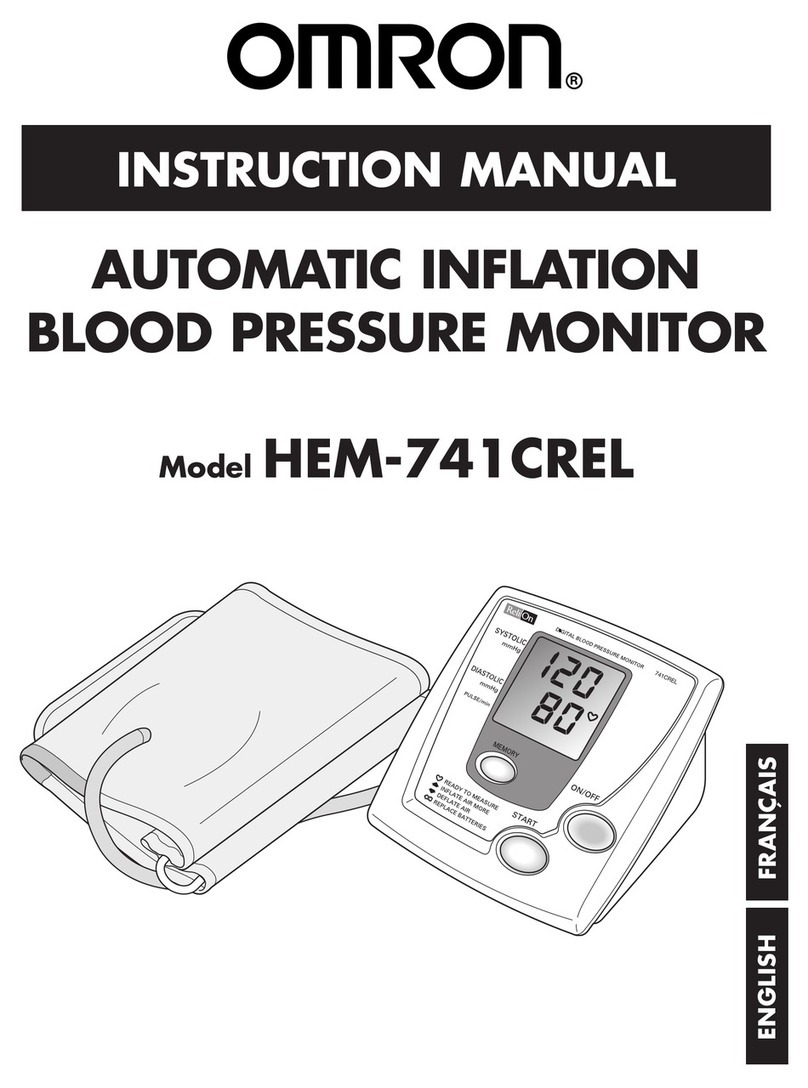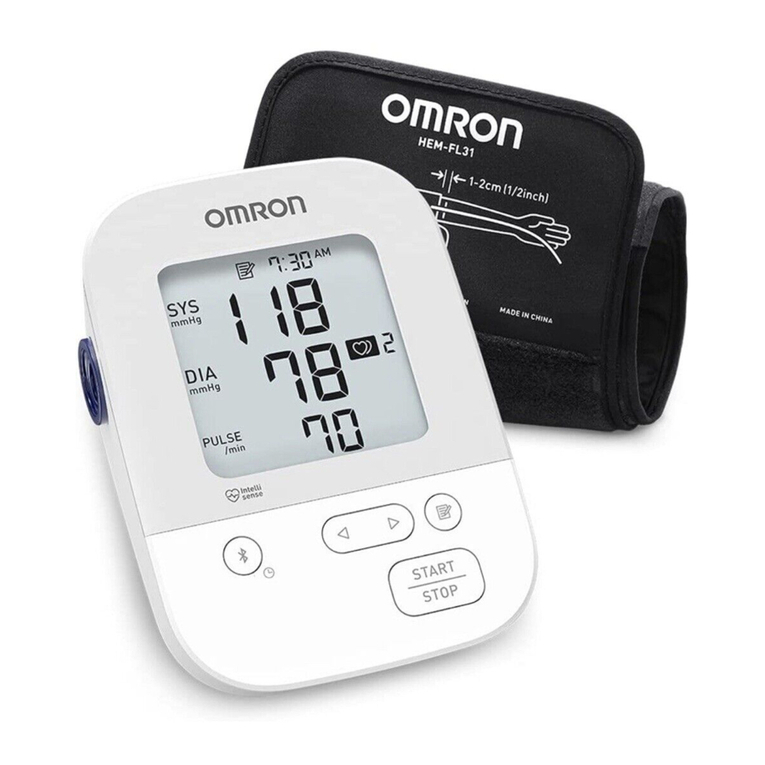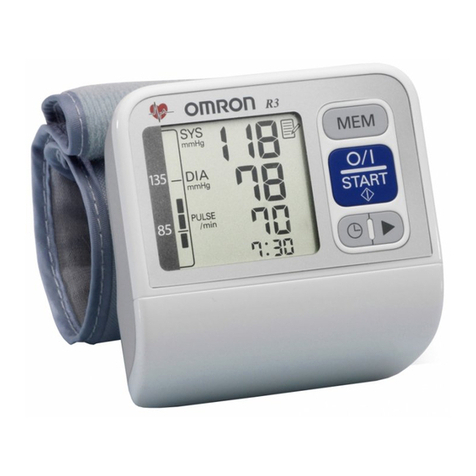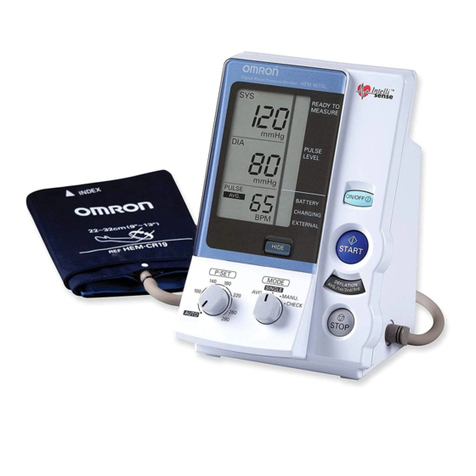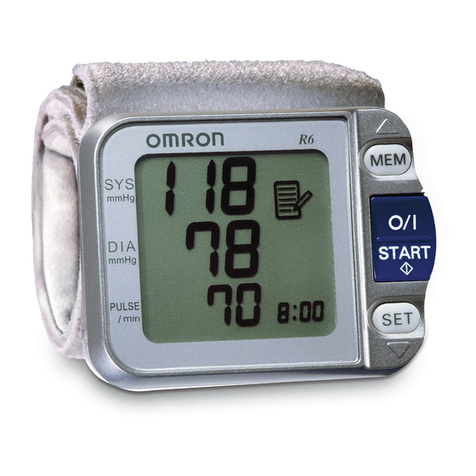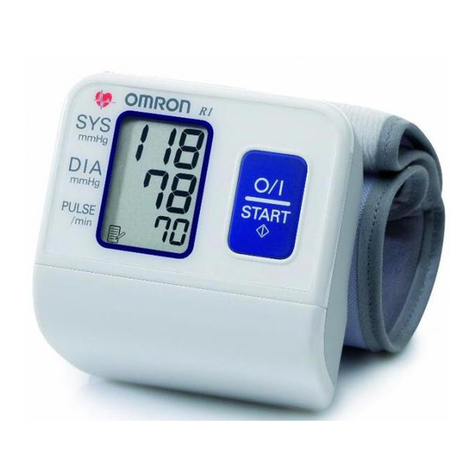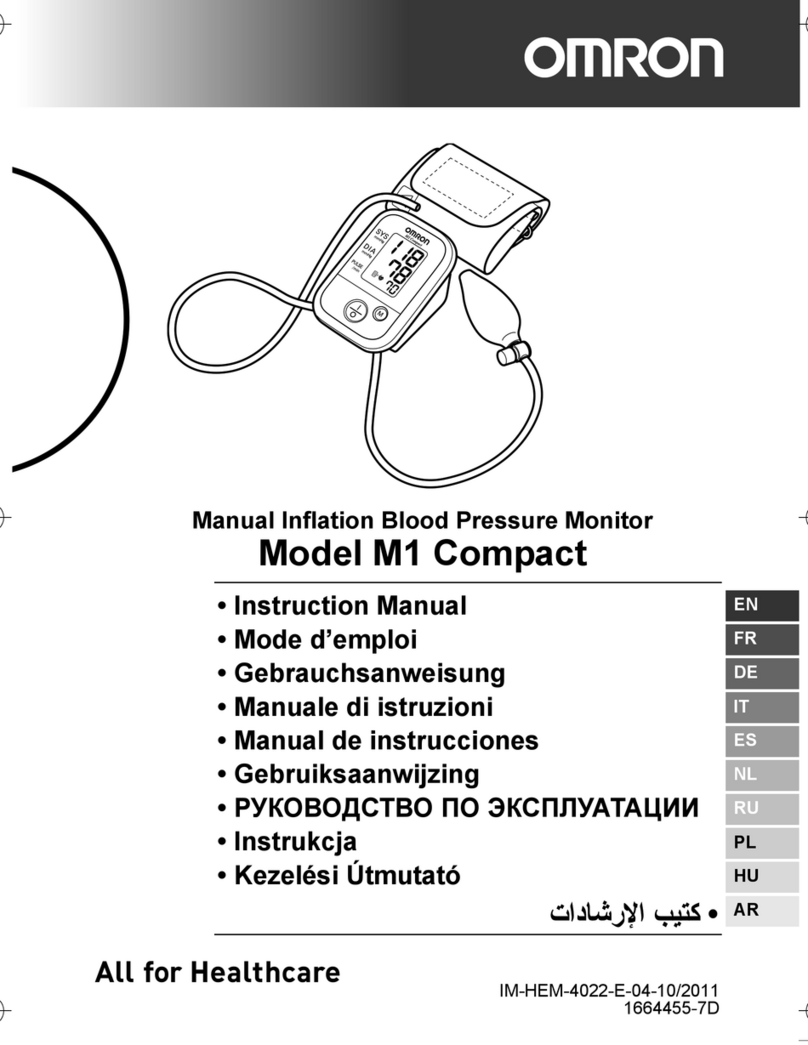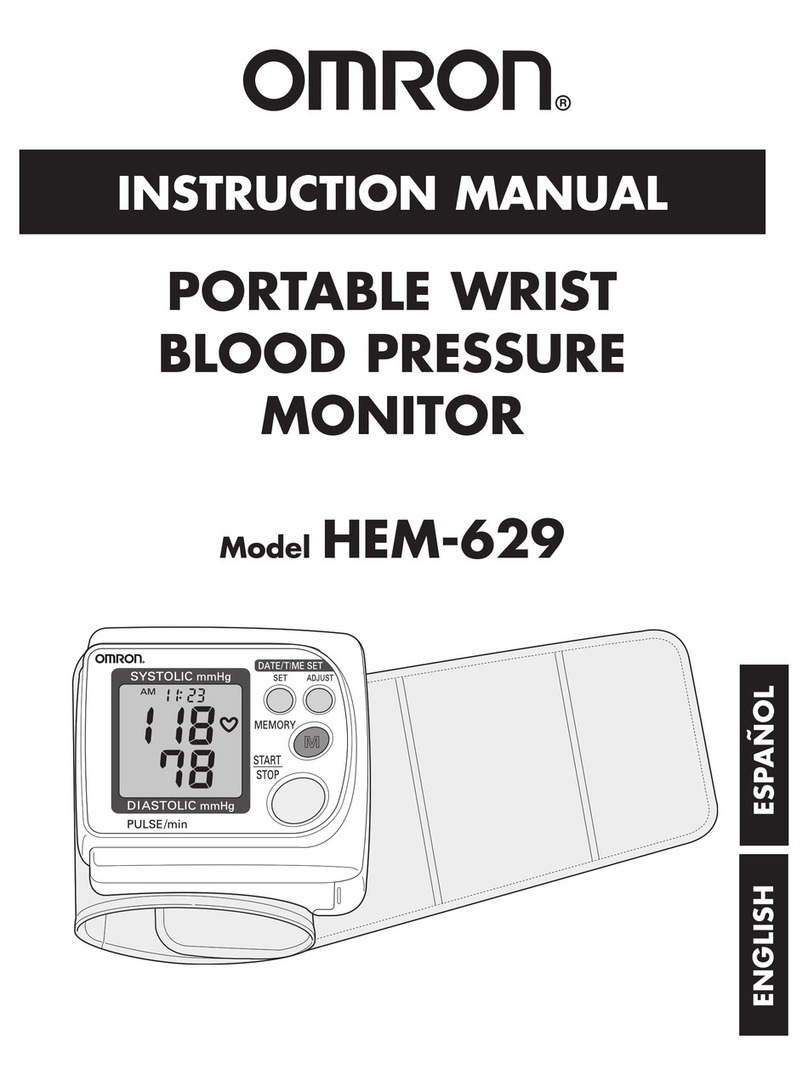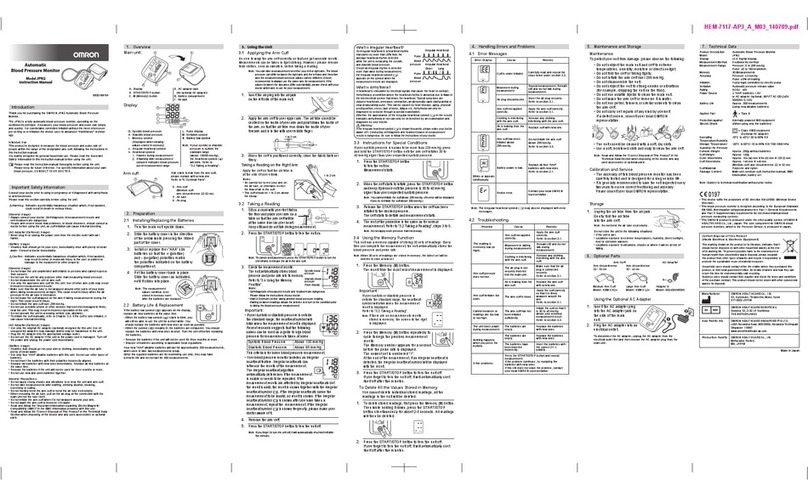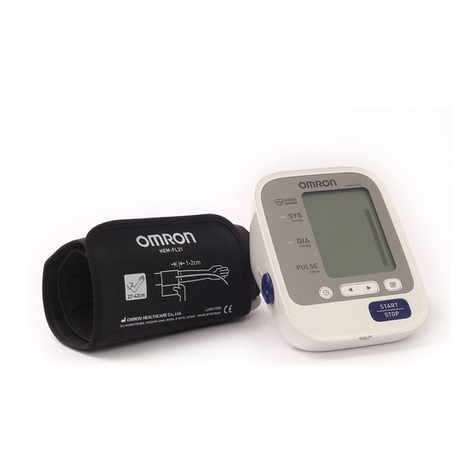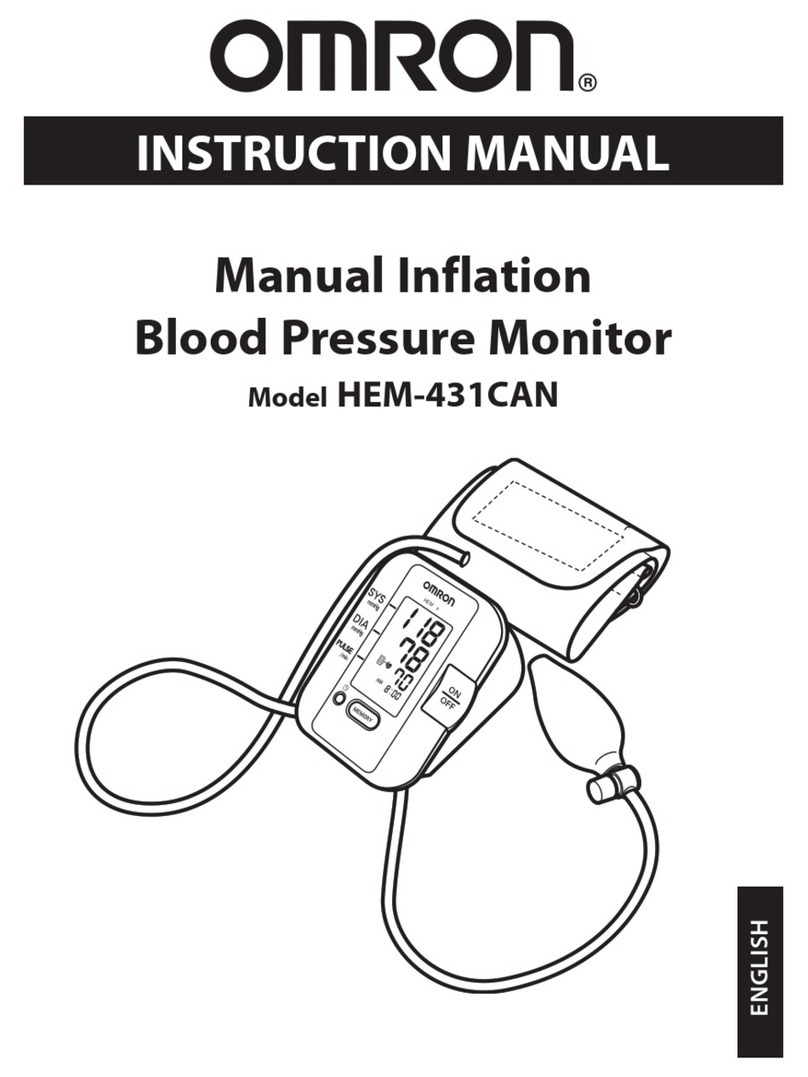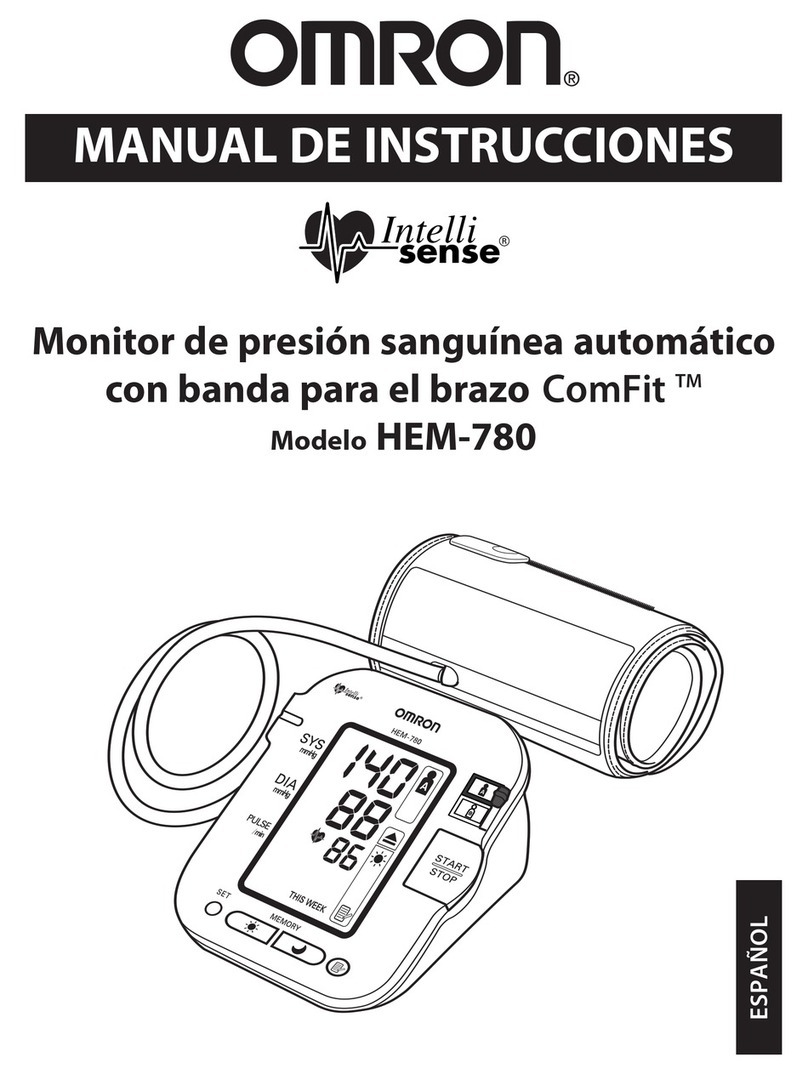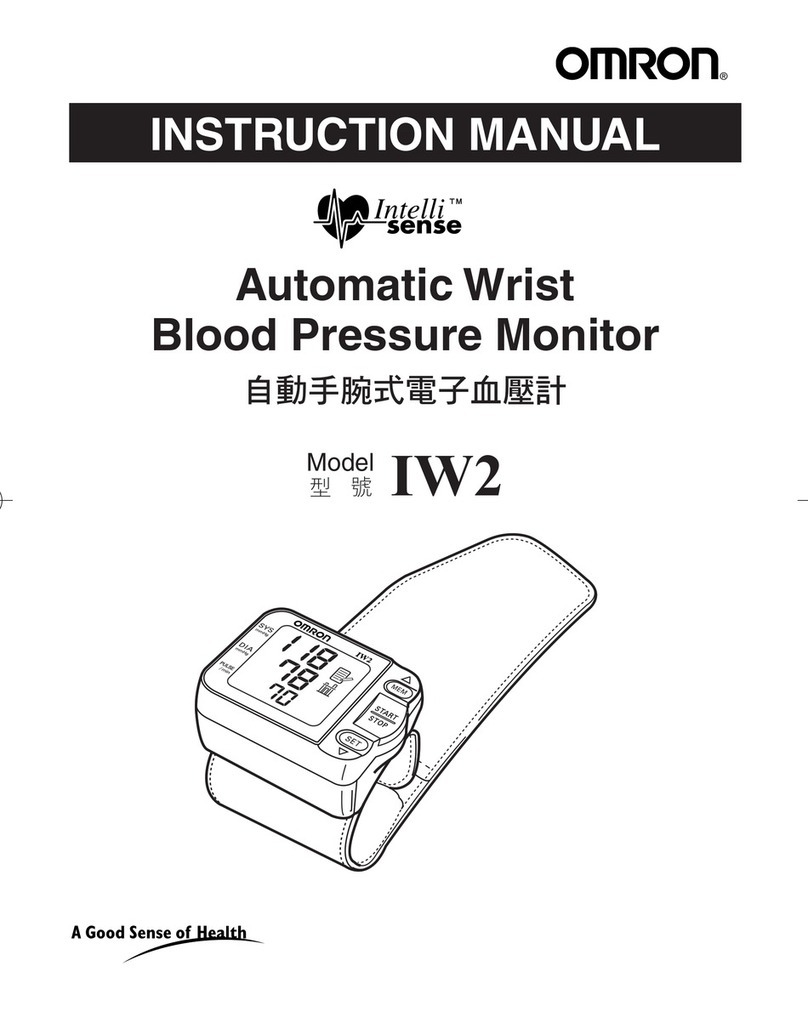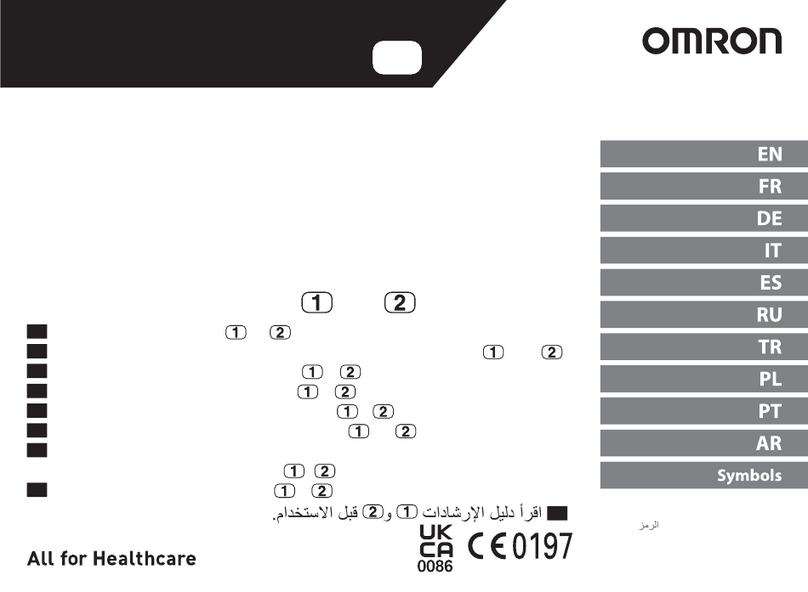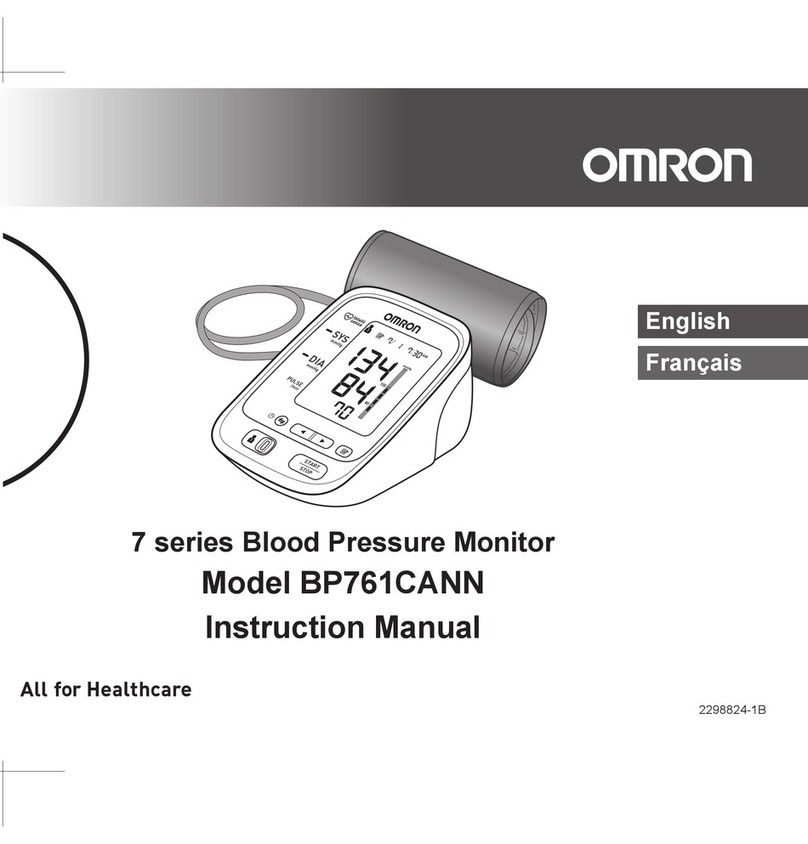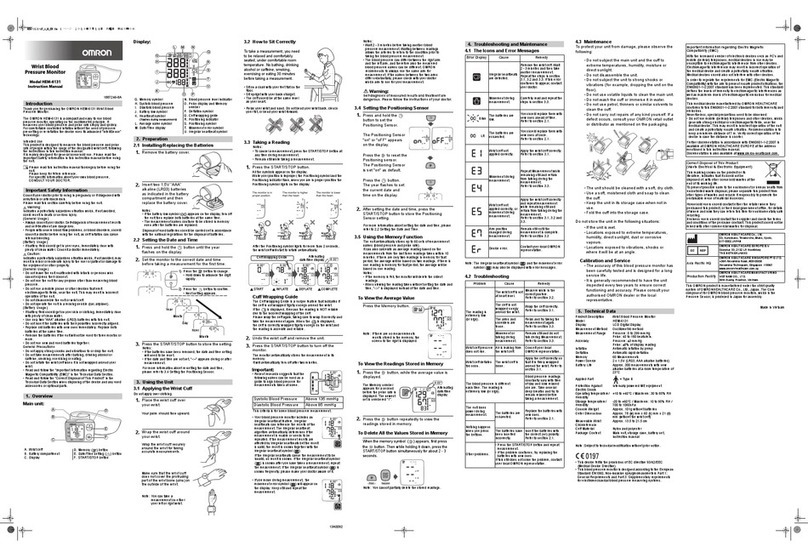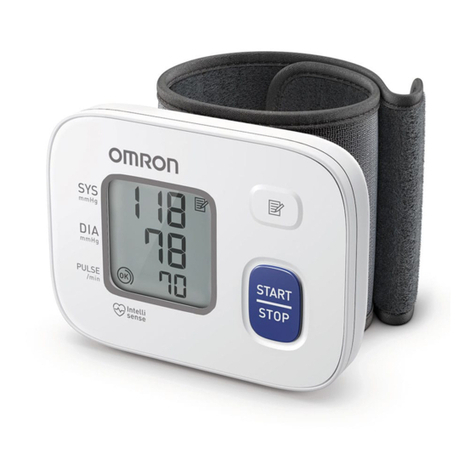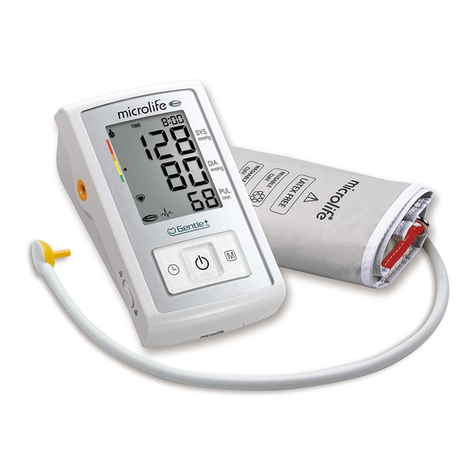4. Mensajes de error y solución de problemas
4.1 Mensajes de error
4.2 Solución de problemas
5. Mantenimiento y almacenamiento
5.1 Mantenimiento
Para proteger su dispositivo de cualquier daño, observe lo
siguiente:
• Guarde el dispositivo y los componentes en un lugar limpio
y seguro.
• No use limpiadores abrasivos ni limpiadores volátiles.
• No lave el dispositivo ni ninguno de sus componentes, ni los
sumerja en agua.
• No use gasolina, diluyentes o solventes similares para
limpiar el dispositivo.
• Use un paño suave y seco o un paño húmedo suave y
mojado con jabón neutral para limpiar el monitor y el
brazalete.
• Los cambios o las modificaciones que no hayan sido
aprobados por el fabricante dejarán sin efecto la garantía del
usuario. No desarme ni trate de reparar el dispositivo ni los
componentes. Consulte servicio de atención al cliente.
5.2 Almacenamiento
1. Desenchufe el enchufe macho del aire del enchufe hembra
del aire.
2. Envuelva delicadamente el tubo de aire
en el brazalete.
Nota: No doble demasiado el tubo de aire.
No guarde el dispositivo en las siguientes situaciones:
•Si el dispositivo está mojado.
•Lugares expuestos a temperaturas extremas, humedad, la luz directa del
sol, polvo o vapores corrosivos como la lejía.
•Lugares expuestos a vibraciones, golpes o donde estará en un ángulo.
5.3 Accesorios médicos opcionales
6. Especificaciones
Notas:
• Estas especificaciones están sujetas a cambio sin previo aviso.
• En el estudio de validación clínica, se usó la quinta fase en 85 sujetos para
determinar la presión arterial diastólica.
• El dispositivo no se ha validado para su uso en pacientes en estado de
embarazo.
7. Declaración de la FCC
ADVERTENCIA DE LA FCC
Los cambios o las modificaciones que no estén expresamente aprobados por la
parte responsable encargada del cumplimiento pueden anular la autoridad del
usuario para operar el equipo.
Nota:
Este equipo ha sido probado y cumple con los límites de un dispositivo digital de
Clase B, de acuerdo con la parte 15 de las normas FCC. Estos límites fueron
diseñados para proporcionar una protección razonable contra interferencias
perjudiciales cuando se utilice el equipo en una instalación residencial. Este equipo
genera, utiliza y puede irradiar energía de radiofrecuencia y, si no se instala y se
utiliza de acuerdo con las instrucciones, puede provocar interferencias perjudiciales
en las comunicaciones por radio. Sin embargo, no hay garantías de que no se
producirán interferencias en una instalación en particular. Si este equipo provoca
interferencias perjudiciales a la recepción de radio o televisión, lo que se puede
determinar apagando y encendiendo el equipo, se sugiere que el usuario intente
corregir la interferencia a través de una o más de las siguientes medidas:
• Reoriente o reubique la antena receptora.
• Aumente la distancia entre el equipo y el receptor.
• Conecte el equipo a un tomacorrientes que esté en un circuito distinto de aquél al
que se encuentra conectado el receptor.
• Consulte al distribuidor o a un técnico experimentado en radio/TV para asistencia.
8. Garantía limitada
Su Monitor de Presión Arterial Automático BP710N, excluyendo el brazalete, está
garantizado como libre de defectos en materiales y mano de obra que se presenten
dentro de los 2 años a partir de la fecha de compra, si se usa de acuerdo con las
instrucciones que se suministran con el monitor. El brazalete está garantizado
como libre de defectos en materiales y mano de obra que se presenten dentro de
1 año a partir de la fecha de compra, si el monitor se usa de acuerdo con las
instrucciones que se suministran con el monitor. Esta garantía se extiende
únicamente al comprador original.
A consideración nuestra, reemplazaremos, sin costo alguno, cualquier monitor o
brazalete cubierto por la antedicha garantía. El reemplazo es nuestra única
responsabilidad y su único recurso en virtud de la garantía provista.
Para obtener servicio de garantía, llame a Servicio al Cliente al 1-800-634-4350
para obtener la dirección del centro de inspección y el costo de manejo y envío.
Anexe el recibo original impreso. Incluya una carta con su nombre, dirección,
número de teléfono y la descripción del problema específico. Empaque el producto
cuidadosamente para evitar que se dañe durante el traslado. Debido a la
posibilidad de extravío durante el transporte, le recomendamos que asegure el
producto con confirmación de entrega.
LA GARANTÍA ANTES MENCIONADA ES LA ÚNICA GARANTÍA PROVISTA POR
OMRON EN RELACIÓN A ESTE PRODUCTO, Y POR MEDIO DE LA PRESENTE
OMRON NIEGA CUALQUIER OTRA GARANTÍA, EXPLÍCITA O IMPLÍCITA,
INCLUYENDO LAS GARANTÍAS IMPLÍCITAS DE COMERCIABILIDAD Y
APTITUD PARA PROPÓSITOS PARTICULARES. LAS GARANTÍAS IMPLÍCITAS
Y OTROS TÉRMINOS IMPUESTOS POR LEY, SI EXISTIERAN, SE LIMITAN AL
PERIODO DE DURACIÓN DE LA GARANTÍA EXPRESA.
OMRON NO ES RESPONSABLE POR LA PÉRDIDA DE USO, NI POR NINGÚN
OTRO COSTO, GASTO O DAÑO ESPECIAL, FORTUITO, CONSECUENTE O
INDIRECTO.
Esta garantía le proporciona derechos legales específicos y usted puede tener
otros derechos que varíen por jurisdicción. Debido a especiales requisitos locales,
es posible que algunas de las limitaciones y exclusiones antes mencionadas no
apliquen en su caso.
9. Guía y declaración del fabricante
Monitor de Presión Arterial Automático OMRON
Información para los documentos incluidos en el ámbito de aplicación del
IEC60601-1-2:2007
Modelo: BP710N
Indicador
de error
Causa Solución
Se detectan latidos irregulares.
Retire el brazalete. Espere de
2 a 3 minutos y luego realice
otra medición. Repita los pasos
en section 3.3. Si este error
continúa apareciendo,
comuníquese con su médico.
Movimiento durante la medición. Lea detenidamente y repita los
pasos en section 3.3.
Las pilas están bajas.
Debe cambiar las pilas por pilas
nuevas con anticipación.
Consulte section 2.1.
Las pilas están descargadas.
Debe cambiar las pilas por pilas
nuevas de inmediato.
Consulte section 2.1.
El conector del tubo de aire no
está conectado.
Introduzca el conector de modo
que quede firme.
Consulte section 3.1.
El brazalete está colocado
muy suelto.
Coloque el brazalete más
ajustado.
Consulte section 3.1.
El brazalete tiene una fuga
de aire.
Reemplace el brazalete por uno
nuevo.
Consulte section 5.3.
Movimiento durante la medición
y el brazalete no se ha inflado lo
suficiente.
Repita la medición. Permanezca
quieto y no hable durante la
medición.
Consulte section 3.3.
Si aparece “E2” repetidamente,
infle manualmente el brazalete
hasta que quede de 30 a
40 mmHg por encima del
resultado de su medición anterior.
Consulte section 3.3.
Al inflar el brazalete se excedió
la presión máxima permitida y el
brazalete se desinfló
automáticamente al inflarlo de
forma manual.
No toque ell brazalete y/o doble
el tubo de aire mientras toma
una medición. No infle el
brazalete más de lo que sea
necesario.
Consulte section 3.3.
Movimiento durante la medición.
Repita la medición. Permanezca
quieto y no hable durante la
medición.
Consulte section 3.3.
La vestimenta interfiere con el
brazalete.
Quite toda prenda que interfiera
con el brazalete.
Consulte section 3.1.
Error en el dispositivo. Póngase en contacto con el
servicio de atención al cliente.
Problema Causa y Solución
No hay alimentación eléctrica.
No aparece ningún símbolo en la
pantalla del monitor.
Reemplace todas las pilas por unas
nuevas.
Verifique si las polaridades de las pilas
están correctamente colocadas.
Consulte section 2.1.
Los valores de medición parecen ser
demasiado altos o demasiado bajos.
La presión arterial varía
constantemente. Muchos factores,
incluyendo el estrés, la hora del día, la
forma en que se coloca el brazalete,
pueden afectar su presión arterial.
Repase la section 1.2 y section 3.3.
Brazalete
Circunferencia del brazo
7" - 9" (17 - 22 cm)
Circunferencia del brazo
9" - 17" (22 - 42 cm)
CD-CS9
(Modelo: HEM-CS24)
CD-WR17
(Modelo: HEM-RML31)
Modelo BP710N HEM-7121-Z
Pantalla Pantalla digital LCD
Rango de medición Presión: 0 a 299 mmHg
Pulso: 40 a 180 latidos/min.
Precisión Presión: ±3 mmHg o 2% de lectura
Pulso: ±5% de lectura en pantalla
Inflado Controlado con lógica difusa mediante bomba eléctrica
Desinflado Válvula de liberación automática de presión
Método de medición Método oscilométrico
Clasificación IP IP 20
Fuente de alimentación
4 pilas “AA” de 1.5V
Vida útil de las pilas Aproximadamente 1000 mediciones (usando pilas alcalinas nuevas)
Temperatura de
operación / humedad 50°F a 104°F (10°C a 40°C) / 15 a 90% RH
Temperatura de
almacenamiento /
humedad / presión
de aire
-4°F a 140°F (-20°C a 60°C) / 10 a 95% RH / 700 a 1060hPa
Peso Monitor: Aproximadamente 250g (8 7/8 oz.), sin incluir las pilas
Brazalete: Aproximadamente 170 g (6 oz.)
Dimensiones Monitor: Aproximadamente 4" (ancho) ×3 1/8" (alto) ×5 1/8" (largo)
(103mm ×80mm ×129mm)
Brazalete : Aproximadamente 5 3/4" ×23 1/2" (tubo de aire: 29 1/2")
(145 mm ×594 mm (tubo de aire: 750 mm))
Circunferencia del
brazalete 9" a 17" (220 a 420 mm)
Memoria Hasta 14
Contenido
Monitor, brazalete, manual de instrucciones, guía resumida
Parte sobre la cual se
realiza la medición
Protección contra
descargas eléctricas
Equipo médico eléctrico alimentado internamente
= Tipo BF
PARA COMUNICARSE CON ATENCIÓN AL CLIENTE
Visite nuestro sitio Web en: www.omronhealthcare.com
Llame sin cargo al: 1-800-634-4350
Información importante sobre la Compatibilidad electromagnética (EMC)
Debido al creciente número de dispositivos electrónicos existentes, como computadoras y
teléfonos celulares, es posible que los dispositivos médicos sean susceptibles a las
interferencias electromagnéticas recibidas de otros dispositivos. Las interferencias
electromagnéticas podrían provocar un funcionamiento incorrecto del dispositivo médico y
crear una situación potencialmente insegura. Los dispositivos médicos tampoco deberían
interferir con otros dispositivos.
Con el objeto de regular los requisitos para EMC (Compatibilidad electromagnética) y evitar
situaciones poco seguras del producto, se ha implementado el estándar IEC60601-1-2. Este
estándar define los niveles de inmunidad a interferencias electromagnéticas, así como los
niveles máximos de emisiones electromagnéticas para dispositivos médicos.
Los dispositivos médicos fabricados por OMRON Healthcare cumplen con este estándar
IEC60601-1-2:2007 tanto para inmunidad como emisiones.
Sin embargo, es necesario tomar precauciones especiales:
• El uso de accesorios y cables no especificados por OMRON, con la excepción de los cables
vendidos por OMRON como repuesto para componentes internos, podría provocar un
incremento de emisiones o una reducción en la inmunidad del dispositivo.
• Un dispositivo médico no deben utilizarse junto o encima de otro equipo.
En el caso de que sea necesario usarlo bajo estas circunstancias, el dispositivo médico
debe ser controlado para verificar su normal operación en la configuración en el que
será utilizado.
• Para mayor información respecto al ambiente de compatibilidad electromagnética (EMC) en
el que se debe usar el dispositivo, consulte la guía a continuación.
• El EQUIPO MÉDICO ELÉCTRICO BP710N necesita de precauciones especiales respecto a
la EMC y se necesita instalar y operar de acuerdo a la información de EMC incluida en estos
documentos.
• La función principal del BP710N es medir la presión arterial y la frecuencia del pulso,
así como la función de memoria.
El BP710N puede sufrir la interferencia de otros equipos, aun si dichos equipos cumplen con
las normas de EMISIÓN de CISPR.
Guía y declaración del fabricante – emisiones electromagnética
El BP710N de OMRON está diseñado para ser utilizado en el entorno electromagnético especificado abajo.
El cliente o usuario del BP710N de OMRON deberá asegurarse del uso del dispositivo en dicho entorno.
Prueba de
emisiones Cumplimiento Entorno electromagnético - guía
Emisiones RF
CISPR 11 Grupo 1
El BP710N de OMRON usa energía de RF sólo para su
funcionamiento interno. Por lo tanto, sus emisiones RF son
muy bajas y es improbable que provoquen interferencias
en equipos electrónicos cercanos.
Emisiones RF
CISPR 11 Clase B
El uso del BP710N de OMRON es adecuado en cualquier
ámbito, incluso ámbitos domésticos y los conectados
directamente a la red pública de bajo voltaje que abastece
a los edificios destinados a vivienda.
Emisiones
armónicas
IEC 61000-3-2 No aplica.
Fluctuaciones de
voltaje/
emisiones de
parpadeo
IEC61000-3-3
No aplica.
Guía y declaración del fabricante – inmunidad electromagnética
El BP710N de OMRON está diseñado para ser utilizado en el entorno electromagnético especificado abajo.
El cliente o usuario del BP710N de OMRON deberá asegurarse del uso del dispositivo en dicho entorno.
Prueba de
inmunidad
IEC 60601 nivel de
prueba
Nivel de
cumplimiento
Entorno electromagnético -
guía
Descarga
electrostática (ESD)
IEC 61000-4-2
±6 kV por contacto
±8 kV al aire
±6 kV por contacto
±8 kV al aire
El suelo debe ser de madera,
cemento o azulejo. Si los suelos
están revestidos de material
sintético, la humedad relativa
debería ser por lo menos
del 30%.
Transitorioseléctricos
rápidos/en ráfagas
IEC 61000-4-4
±2 kV para líneas de
suministro de energía
±1 kV para líneas de
entrada/salida
No aplica. No aplica.
Sobrevoltaje
IEC 61000-4-5
±1 kV entre fases
±2 kV de línea a tierra No aplica. No aplica.
Caídas de voltaje,
interrupciones cortas
y variaciones de
voltaje de las líneas
de entrada del
suministro de energía
IEC 61000-4-11
<5 % U
T
(>95 % de caída
con respecto al U
T
)
durante 0.5 ciclos
No aplica. No aplica.
40 % UT(60 % de caída
con respecto al UT)
durante 5 ciclos
70 % UT(30 % de caída
con respecto al UT)
durante 25 ciclos
<5 % UT(95 % de caída
con respecto al UT)
durante 5 segundos
Campo magnético
(50/60 Hz) de la
frecuencia de línea
IEC 61000-4-8
3 A/m 3 A/m
Los campos magnéticos de la
frecuencia de línea deben tener
los niveles propios de un lugar
típico en un entorno comercial u
hospitalario típico.
Nota: UTes la tensión de red CA antes de la aplicación del nivel de prueba.
Guía y declaración del fabricante – inmunidad electromagnética
El BP710N de OMRON está diseñado para ser utilizado en el entorno electromagnético especificado abajo.
El cliente o usuario del BP710N de OMRON deberá asegurarse del uso del dispositivo en dicho entorno.
Prueba de
inmunidad
IEC 60601
nivel de
prueba
Nivel de
cumplimiento
Entorno electromagnético - guía
RF conducida
IEC 61000-4-6
RF irradiada
IEC 61000-4-3
3 Vrms
150 kHz a
80 MHz
3 V/m
80 MHz a
2.5 GHz
No
corresponde.
3 V/m
Los equipos de comunicaciones por RF portátiles y
móviles no deben ser usados cerca de ninguna parte
del BP710N, incluyendo los cables, a una distancia
menor que la recomendada, calculada a partir de la
ecuación aplicable a la frecuencia del transmisor.
Distancia de separación recomendada
No corresponde.
d = 1.2 √P
80 MHz a 800 MHz
d = 2.3 √P
800 MHz a 2.5 GHz
donde P es la potencia máxima de salida del
transmisor en vatios (W) según el fabricante del
transmisor y d es la distancia de separación
recomendada en metros (m).
Las intensidades de campo de transmisores RF fijos,
según lo que determine la prueba electromagnética in
situ,adeben ser menores al nivel de cumplimiento en
cada rango de frecuencias.b
Puede haber interferencias cerca de equipos
marcados con el siguiente símbolo:
Nota 1: A 80 MHz y 800 MHz, se aplica el rango de frecuencias más alto.
Nota 2: Es posible que estas directrices no se apliquen en todas las situaciones. La propagación
electromagnética es afectada por la absorción y el reflejo en estructuras, objetos y personas.
a
Las intensidades de campo de los transmisores fijos, tales como estaciones de base por radioteléfonos
(celulares/inalámbricos) y radios móviles terrestres, emisoras de radio AM y FM y emisiones de televisión,
no se pueden predecir teóricamente con exactitud. Para evaluar el entorno electromagnético provocado
por transmisores de RF fijos, se debería considerar la posibilidad de realizar una prueba electromagnética
in situ. Si la intensidad de campo medida en el lugar donde habrá de usarse el BP710N de OMRON
excede el nivel de cumplimiento de RF correspondiente indicado arriba, el BP710N de OMRON deberá
ser observado para verificar su funcionamiento normal. Si se observa una anomalía en el funcionamiento,
puede que sea necesario tomar medidas adicionales como reorientar o trasladar el BP710N de OMRON.
b
En el rango de frecuencias de 150 kHz a 80 MHz, las intensidades de campo deberían ser menores a 3 V/m.
Distancias recomendadas entre equipos de comunicación por RF portátiles y móviles
y el BP710N de OMRON
El BP710N de OMRON está destinado para ser usado en un entorno electromagnético en el que las
alteraciones por RF irradiada sean controladas. El cliente o usuario de este BP710N de OMRON
puede ayudar a evitar la interferencia electromagnética guardando una distancia mínima entre los
equipos portátiles y móviles de comunicación RF (transmisores) y el BP710N de OMRON, tal como
se recomienda a continuación, según la potencia máxima de salida del equipo de comunicación.
Potencia máxima de salida
nominal en Vatios
Distancia de separación según la frecuencia del
transmisor en metros
150 kHz a 80 MHz
No corresponde.
80 MHz a 800 MHz
d= 1.2 √P
800 MHz a 2.5GHz
d= 2.3 √P
0.01
No corresponde.
0.12 0.23
0.1 0.38 0.73
11.22.3
10 3.8 7.3
100 12 23
Para transmisores con una potencia máxima de salida que no figure en la tabla precedente, la
distancia recomendada den metros (m) se puede determinar por medio de la ecuación que se aplica
a la frecuencia del transmisor, donde Pes la potencia máxima de salida del transmisor en vatios (W),
según el fabricante del transmisor.
Nota: A 80 MHz y 800 MHz, se aplica la distancia para el rango de frecuencias más alto.
Nota: Es posible que estas directrices no se apliquen en todas las situaciones. La propagación
electromagnética es afectada por la absorción y el reflejo en estructuras, objetos y personas.
Fabricado para: OMRON HEALTHCARE Co., Ltd.
53, Kunotsubo, Terado-cho, Muko, Kyoto, 617-0002 JAPAN
Distribuido por: OMRON HEALTHCARE, INC.
1925 West Field Court, Lake Forest, IL 60045 U.S.A.
www.omronhealthcare.com
© 2013 OMRON HEALTHCARE, INC.
Hecho en Vietnam
HEM-7121-Z_D_M.book Page 2 Tuesday, September 2, 2014 1:12 PM
